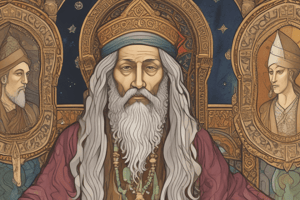Podcast
Questions and Answers
What is the difference between universal and ethnic religions?
What is the difference between universal and ethnic religions?
Universal religions aim for conversion, while ethnic religions are tied to a specific group.
What are the main religions in each category?
What are the main religions in each category?
Universal: Christianity; Ethnic: Hinduism.
What is the difference between branches, denominations, and sects?
What is the difference between branches, denominations, and sects?
Branch is a large division within a religion; denomination is a division of a branch; sect is a small group breaking away from a denomination.
Which is the world's largest religion both in number of adherents and spatial extent? Roughly what percentage of the world's population follows this religion?
Which is the world's largest religion both in number of adherents and spatial extent? Roughly what percentage of the world's population follows this religion?
What are the three main divisions within Christianity?
What are the three main divisions within Christianity?
Where in the world does Eastern Orthodoxy predominate?
Where in the world does Eastern Orthodoxy predominate?
Organizationally, would you say that Eastern Orthodoxy is united or fragmented?
Organizationally, would you say that Eastern Orthodoxy is united or fragmented?
What branch of Christianity accounts for about one-half of all Christians?
What branch of Christianity accounts for about one-half of all Christians?
Describe the broad spatial distribution of the main Christian denominations within Europe.
Describe the broad spatial distribution of the main Christian denominations within Europe.
Describe the main features of the denominational map of the United States and Canada.
Describe the main features of the denominational map of the United States and Canada.
In what way do North America and Latin America differ religiously?
In what way do North America and Latin America differ religiously?
Roughly how many people around the world are Muslims?
Roughly how many people around the world are Muslims?
Describe the spatial distribution of Islam. Which five countries have the largest number of Muslims?
Describe the spatial distribution of Islam. Which five countries have the largest number of Muslims?
When did Islam originate?
When did Islam originate?
What is the relationship, if any, between the God that Muslims, Christians, and Jews worship?
What is the relationship, if any, between the God that Muslims, Christians, and Jews worship?
How do Muslims conceive Mohammed?
How do Muslims conceive Mohammed?
How do Muslims conceive of Jesus Christ?
How do Muslims conceive of Jesus Christ?
Which of the major faiths are monotheistic?
Which of the major faiths are monotheistic?
What, exactly, is the Koran?
What, exactly, is the Koran?
What are the five pillars of Islam?
What are the five pillars of Islam?
What is the major division within Islam?
What is the major division within Islam?
To which branch do most Muslims belong?
To which branch do most Muslims belong?
Which country has by far the largest concentration of Shi'ites?
Which country has by far the largest concentration of Shi'ites?
How and where did Buddhism originate?
How and where did Buddhism originate?
What are the Four Noble Truths?
What are the Four Noble Truths?
Describe the spatial distribution of Buddhism.
Describe the spatial distribution of Buddhism.
Flashcards are hidden until you start studying
Study Notes
Religious Categories
- Universal religions aim for a global reach and focus on converting others.
- Ethnic religions are tied to specific cultural or ethnic groups, often closely linked to heritage.
Major World Religions
- Christianity is a universal religion.
- Hinduism is categorized as an ethnic religion.
Religious Divisions
- A branch represents a significant division within a religion.
- A denomination is a subset of a branch, consisting of multiple congregations under a legal and administrative structure.
- A sect is a smaller group that has separated from an established denomination.
Largest Religion
- Christianity is the largest religion globally, with approximately 31% of the world’s population identifying as adherents.
Christianity's Major Divisions
- The three main divisions within Christianity are Roman Catholicism, Protestantism, and Eastern Orthodoxy.
Eastern Orthodoxy's Distribution
- Predominantly found in Slavic Europe and Russia.
Organizational Unity of Eastern Orthodoxy
- Historically united, Eastern Orthodoxy is showing signs of increasing fragmentation.
Major Branch of Christianity
- Roman Catholicism accounts for about half of all Christians worldwide.
Christian Denominations in Europe
- Eastern Europe mainly practices Eastern Orthodoxy.
- Northern Europe, along with parts of Great Britain and Germany, is predominantly Protestant.
- Southern and Western Europe is primarily Catholic.
Religious Landscape of North America and Canada
- Catholicism dominates in Eastern Canada and pockets of the U.S.
- The Northeast U.S. and parts of the Central U.S. lean Catholic, while the Southeast and Midwest are predominantly Protestant.
- Alaska exhibits a roughly equal mix of Catholic and Protestant populations.
Religious Differences Between Americas
- Latin America is predominantly Catholic, whereas North America is more evenly split between Catholicism and Protestantism.
Global Muslim Population
- Approximately 1.6 billion Muslims exist globally, roughly 1 in every 5 people.
Distribution of Islam
- Majority of Muslims are located in Southeast Asia, not the Middle East.
- The five countries with the largest Muslim populations are Indonesia, India, Pakistan, Bangladesh, and Nigeria.
Origin of Islam
- Islam originated in the 6th or 7th century.
Commonality of God in Abrahamic Faiths
- Muslims, Christians, and Jews worship the same deity, albeit with different names.
Perception of Muhammad in Islam
- Muhammad is viewed as the messenger of God who revealed the words recorded in the Koran.
Jesus Christ in Islam
- Jesus is recognized as a messenger but is not considered divine.
Monotheistic Faiths
- Major monotheistic religions include Christianity, Islam, and Judaism.
Definition of the Koran
- The Koran is regarded as the literal word of God as conveyed to Muhammad.
The Five Pillars of Islam
- Belief in the oneness of Allah.
- Five daily prayers facing Mecca.
- Annual almsgiving to assist the less fortunate.
- Fasting during Ramadan from dawn until sunset.
- The pilgrimage to Mecca is mandatory for all capable Muslims at least once in their lifetime.
Major Islamic Divisions
- Shiite Islam believes leadership should have stayed within Muhammad's family, while Sunni Islam holds that any wise individual can lead.
Predominant Branch of Islam
- Sunni Islam is the largest branch, encompassing most Muslims worldwide.
Concentration of Shi'ites
- Iran has the largest population of Shi'ite Muslims.
Origin of Buddhism
- Buddhism emerged in Northern India, specifically in Nepal, and is rooted in Hinduism.
The Four Noble Truths
- Life is inherently filled with suffering.
- Desire and attachment cause suffering.
- Suffering can end through the cessation of desire.
- Overcoming desire is achieved through following the Eightfold Path.
Buddhism's Spatial Distribution
- 99% of Buddhists reside in Southeast and South Asia.
Studying That Suits You
Use AI to generate personalized quizzes and flashcards to suit your learning preferences.



